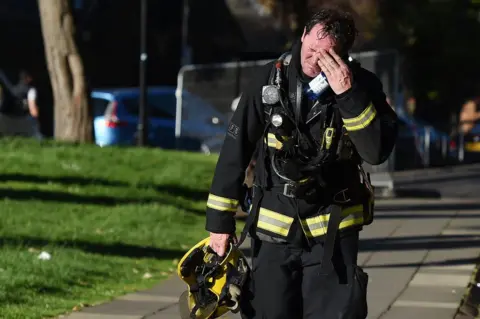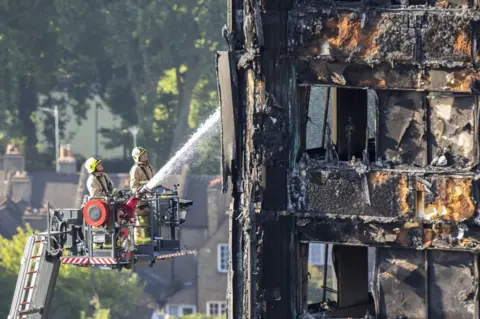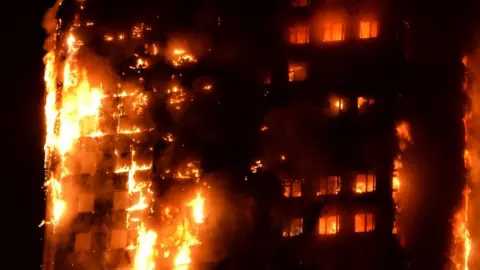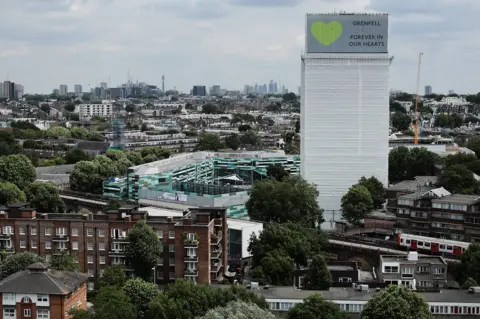Grenfell Tower: Five things firefighters told us about the fire
Firefighters have been giving evidence to the Grenfell Tower Inquiry. As the inquiry now prepares to begin hearing from the families of the victims, here are five key things we've learned so far.
1. Firefighters were at risk, but they went in anyway
 EPA
EPAMany of the firefighters who fought the Grenfell Tower inferno believed they were going to die.
In an age where serious fires have become rarer, this was a disaster way beyond their daily experience. Yet they responded with true heroism.
They include:
- Daniel Brown, who hung out of a fourth floor flat to fight the flames
- David Badillo, who repeatedly climbed the smoke-filled stairwell in attempt to save a 12-year-old girl
Many of the crews described talking to residents they knew could not be saved.
For their willingness to go into a burning tower, a significant number have been repaid with months of sleepless nights, and traumatic memories.
Giving evidence at the inquiry did not make things easier. And there was criticism from the start that the actions of relatively junior officers were being challenged in the daily hearings.
But the inquiry is intent on scrutinising the performance of the fire brigade. And as the process has progressed, questions have been asked of those at all levels in the service.
2. The fire was out of control from the start
 PA
PAIt was fuelled by the plastic in the cladding panels fitted during the tower's refurbishment. But worse than that, the panels themselves made it difficult to tackle the fire.
This is because they were installed as "rainscreen cladding".
In other words, they were designed specifically to keep water away from the building. Several firefighter witnesses described their hoses having no effect on the flames.
The fire may have been unstoppable from the first moments it escaped from flat 16 on the fourth floor and began racing up the outside of the building,
The inquiry will have to decide whether anything could have been done to halt it.
A key piece of evidence will be the pictures of the first "covering jet" of water from a fire hose, which fell short of the window of flat 16.
The inquiry heard suggestions this had been a deliberate tactic. The first team into the building were behind that window and aiming a hose through it might have put them at risk.
You might think that high-rise fires are tackled with huge extendable ladders - but that is not the case. It's not possible to make a ladder long enough for the taller buildings.
The strategy is to fight from inside the building, with fire hoses plugged into the "dry riser" - a pipe fed by fire engines on the ground.
But could that strategy have successfully extinguished a massive fire on the outside of the building?
The London Fire Brigade commissioner, Dany Cotton, said this was never possible.
3. Evacuating the tower was always the last resort
 Getty Images
Getty ImagesIt's an obvious question - why not get everyone out instead of maintaining a policy of telling residents to "stay put"?
The simple answer is that, normally, stay put saves lives. This is because tower blocks are designed to confine the flames to the concrete box forming an individual flat.
So, if you are in a different flat, you are theoretically safe - certainly safer than joining a stampede down smoke-filled stairs.
It makes sense. And the fire service has a system for understanding whether other residents are facing danger.
They give "fire survival guidance" to those calling 999 and pass the information from the caller to teams on the ground, warning them if a rescue is going to be needed.
But it didn't work well at Grenfell because exhausted crews were dealing with more calls than in any fire in modern times.
They were writing information on bits of paper, recording them in pen on stairwell walls or resorting to their mobile phones to communicate, because their radios were not working.
The inquiry may find that even if a rescue had been possible, co-ordinating all of the fire survival guidance calls might have been impossible.
And the stay put policy was swiftly outflanked by the rapidly expanding fire.
Another key question for the inquiry will be whether a new policy needs to be developed for when a fire in a tower gets out of control.
4. The building itself failed its residents
 Getty Images
Getty ImagesIt wasn't just the cladding. Almost all the features of Grenfell Tower designed to be useful in a fire fell short:
- Firefighters arrived to find their normal system for controlling the main lift didn't work
- They constantly got locked out of building when the main self-locking front door slammed shut
- Numbers were missing from the floors so they didn't know where they were
- The water pressure for their hoses was too low
- There were outlets on every other floor, so firefighters had to plug in on the level below where the fires were and run their hoses up a flight of stairs
This meant:
- They had to leave the stairwell doors propped open
- The stairs filled with smoke
- They had to wear breathing equipment with a limited air supply
- People couldn't escape
5. The fire brigade wasn't prepared for such a fire
London has hundreds of tall buildings, ranging from towers such as Grenfell to gleaming skyscrapers.
Yet many of the firefighters who gave evidence revealed they had received limited training on fighting fires in high rises - including fires that had escaped the compartment of a flat and got out of control.
They had no training on how to spot fires made worse by materials such as cladding.
Ms Cotton said firefighters were not building engineers and if they had been taught to analyse the dangers posed by a building's structure, they would have had no time to learn basic firefighting techniques.
But it became clear there had been little planning for a fire like this within the brigade's management, despite a series of smaller fires that warned that something like Grenfell might be a risk.
In fact, the brigade's most senior officer told the inquiry a "towering inferno" such as Grenfell had been about as unlikely as a "space shuttle landing on the Shard", the striking pointed tower near the River Thames.
The brigade's approach was that a cladding fire that raced through a tower, rendering the stay put policy futile, could never happen and could never have been predicted.
The inquiry will have to decide whether that was a reasonable position for London's fire service to take.
